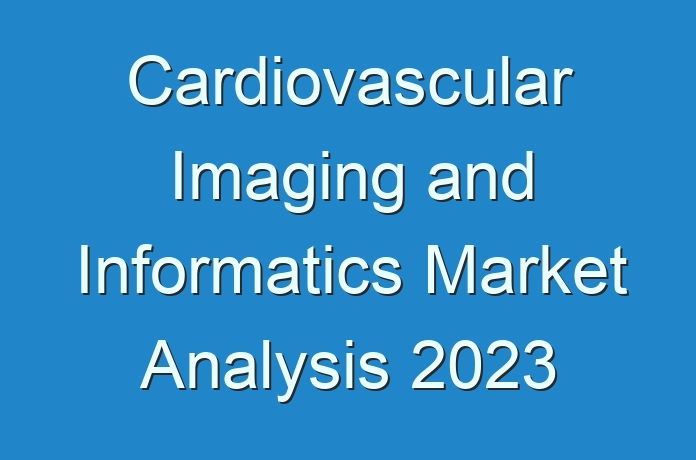
Cardiovascular diseases (CVD) are the most common causes of patient hospitalization and mortality in many developed nations. It continues to be the leading cause of death worldwide as well. It is imperative for a physician to perform cardiovascular imaging test to diagnose heart condition and during subsequent management of any cardiac disorder. Cardiovascular imaging (CV imaging) enables radiologist to see inside the body and shows the structure of heart in great detail. The physician can understand blood flow within the body and diagnose patient’s heart or vascular condition. The global market for cardiovascular imaging is expected to grow in the near future owing to the increasing demand from the emerging economies in the Asia-Pacific and rest of the world. Moreover, the increasing dependence on imaging modalities have increased the adoption of imaging informatics which is expected to witness far-reaching positive impact on the global CV imaging and informatics market.
Echocardiography, angiography, nuclear cardiac imaging, computed tomography, cardiac positron emission tomography (cardiac PET), and cardiac magnetic resonance imaging (cardiac MRI) are the most common imaging modalities used for diagnosis and interventional cardiology. Other tests used for cardiovascular imaging include coronary calcium score and coronary catheterization (catheter angiography). Coronary catheterization is a minimally invasive procedure to access coronary circulation by inserting a catheter into heart through blood vessels in the leg. Cardiac CT is a less invasive option to coronary catheterization which involves injecting CT-visible dye.
Want to know the obstructions to your company’s growth in future? Request a brochure @ https://www.transparencymarketresearch.com/sample/sample.php?flag=S&rep_id=9043
Cardiac CT offers advantage of minimizing the risk of arterial perforation and reduces the chances of infection at catheter injection site. In the late 1970s, CT scans required 2.4-sec for capturing an image, but the development in the electron beam technology has significantly reduced the time per scan. In addition, the development of multi-detector scanners, it has become possible to obtain 64, 128, 256 and more simultaneous slices adding more spatial resolution and diagnostic help to radiologists.
Echocardiography imaging is an optional ultrasound method of cardiac imaging and includes transthoracic echocardiography (TTE), transesophageal echocardiography (TEE), stress echocardiography. Recently, 3D echocardiography is being used for cardiovascular imaging which is non-invasive, easy to operate, and produces much clearer image. Nuclear cardiac imaging is becoming a popular method which involves usage of a radionuclide – technetium Tc 99m sestamibi (MIBI). This non-invasive cardiac imaging method is considered to be one of the best methods to evaluate and diagnose a heart attack. It is also a very handy technique to assess myocardial salvage among patients with acute myocardial infarction (MI). The market for non-invasive cardiovascular imaging is expected to grow rapidly in the coming years as the invasive imaging causes great inconvenience to the patients. Moreover, the non-invasive imaging is less costly and incurs comparatively lesser hospitalization to the patient.
Geographically, the global cardiovascular imaging and informatics market can be segmented into four major regions, North America, Europe, Asia-Pacific and Rest of the world. Geographically, the Asia-Pacific market will witness highest growth in terms of procedures and will outnumber the total imaging procedures in the western part of the world. Large patient pool, increasing healthcare infrastructure and strengthening economy in the region are contributing to the growth of Asia-Pacific cardiovascular imaging and informatics market.
Some of the key companies operating in the cardiac imaging and informatics include GE Healthcare, Siemens Healthcare, Philips Healthcare, Medis Medical Imaging Systems BV, Pie Medical Imaging, and Circle Cardiovascular Imaging, Inc.
This study by TMR is all-encompassing framework of the dynamics of the market. It mainly comprises critical assessment of consumers’ or customers’ journeys, current and emerging avenues, and strategic framework to enable CXOs take effective decisions.
Our key underpinning is the 4-Quadrant Framework EIRS that offers detailed visualization of four elements:
- Customer Experience Maps
- Insights and Tools based on data-driven research
- Actionable Results to meet all the business priorities
- Strategic Frameworks to boost the growth journey
Looking for exclusive market insights from business experts? Request a Custom Report
The study strives to evaluate the current and future growth prospects, untapped avenues, factors shaping their revenue potential, and demand and consumption patterns in the global market by breaking it into region-wise assessment.
The following regional segments are covered comprehensively:
- North America
- Asia Pacific
- Europe
- Latin America
- The Middle East and Africa
The EIRS quadrant framework in the report sums up our wide spectrum of data-driven research and advisory for CXOs to help them make better decisions for their businesses and stay as leaders.
Read Our Trending Press Release Below: https://www.prnewswire.com/news-releases/growing-popularity-of-using-ai-enabled-technologies-to-drive-smart-speakers-market-to-valuation-worth-us18-4-bn-by-2026-end-finds-tmr-report-301012542.html





